On Monday, we reached the northernmost point of the cruise track and we were in thick ice. This meant that it was time to get off the boat and do an ice station. The ship pulled into the ice and “parked†in order for the scientists to disembark and begin a sampling station on top of the Bering Sea ice.Â
Before heading out onto the ice, the Captain held a briefing to tell us the procedure for sampling in the ice. We had to wear special dry suits, Mustang MSD900s in case we fell in. These proved to be challenging to put on but very warm and relatively comfortable for our day on the ice. Other than that, he told us that a rescue swimmer would be out on the ice, a polar bear watch person would be on the ship and another would be on the ice with a rifle in case a polar bear charged. We are generally too far south to see polar bears but they need to follow procedure. Of course, the bear would not be shot as this is only a precaution. If a bear was spotted, we would have to hurry off the ice and let the bear pass through.Â
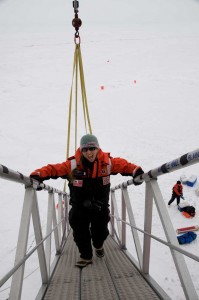
After suiting up, we heading down the brow and out onto the ice with all of the gear. There were a few different research teams heading out to sample and we all found our sampling spots and began work. I was helping Dr. Ned Cokelet and the team from NOAA’s Pacific Marine Environmental Laboratory in Seattle. The team is looking at the physical and chemical properties of ice in order to determine how these parameters affect the organisms that live in the ice (phytoplankton, ice algae and other microscopic critters live in the ice).Â
We set to work to find a good sampling spot and did a preliminary core to check on the thickness of the ice. It was about 30cm thick and it looked like they picked a good spot. The team set out to take two cores with a specialized auger and drill out a series of brine holes to different depths. The two cores are cut into 10cm segments which will be tested for temperature while out on the ice and then salinity, chlorophyll and other nutrients back on board the ship. In this way, the team can get temperature profiles of the ice and profiles of the nutrient and chlorophyll distribution of the ice. The ice is not solid but has brine pockets throughout with varying salinities and levels of nutrients and chlorophyll. The brine wells are dug to various depths and the water that fills them will be tested for salinity, nutrients and chlorophyll as well. This will tell the team what is happening in the ice from a physical standpoint.Â
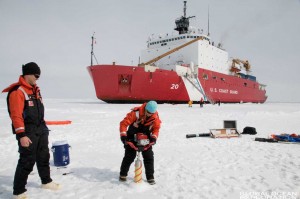
Dylan Righi supervises Gaelin Rosenwaks taking a core in front of the USCGC Healy. This core will be analyzed for the ice algae growing on the bottom. Â
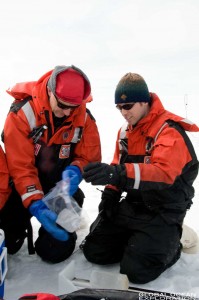
Rolf Sonnerup and David Strausz carefully pack and label samples from an ice core. Â
The samples and information from the PMEL group are important segments in understanding how the sea ice affects the overall ecosystem as it fits into the broader questions of the Bering Sea Ecosystem Project.Â
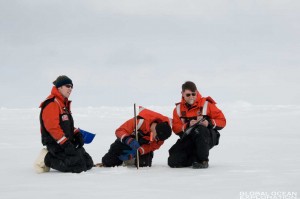
David Strausz, Dylan Righi and Ned Cokelet measure the depth of one of their brine wells before sampling the brine for salinity and other nutrients. Â
After the sampling was completed, we had time to explore the ice and enjoy a little sunshine while atop the Bering Sea! It was amazing to be walking on top of one of the roughest bodies of water in the world. Not only that but it was sunny and warm (well for up here). The rest of the crew was also allowed off the ship and everyone enjoyed an afternoon on the ice playing kickball and just relaxing on what felt like something solid even though we were floating on top of the sea. Viewing the ship from below on the ice made quite an impression and it was interesting to get another vantage point.Â
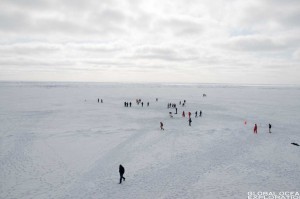
The crew enjoys some time off the ship after the science sampling was completed.
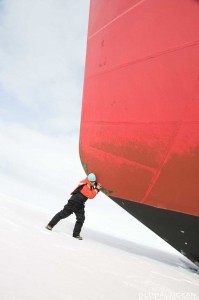
I tried to move the ship. It was too big.Â
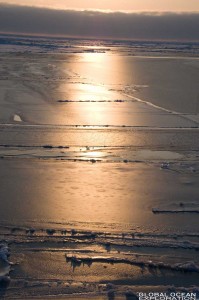
A beautiful sunset capped off a beautiful (rare) “sunshiney†day in the Bering Sea.
Â
Â
